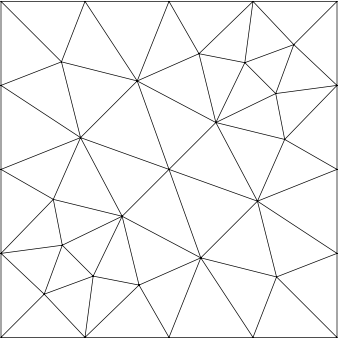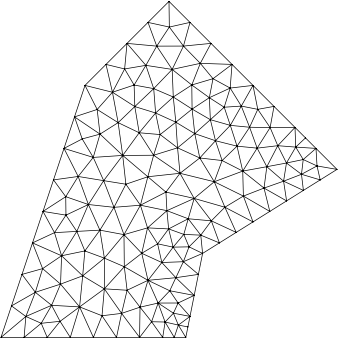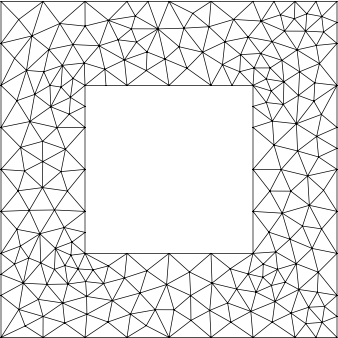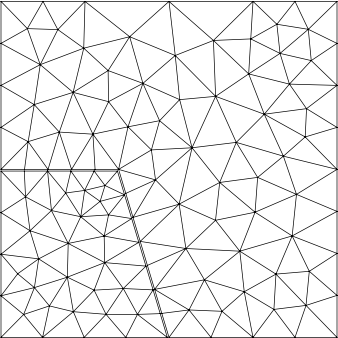Adaptive mesh generation and refinement
Project description
adaptmesh
Create triangular meshes by the adaptive process.
The user feeds in a polygon and a low quality mesh is created. Then the low quality mesh gets improved by adaptive finite elements and mesh smoothing. The approach is detailed here.
Installation
pip install adaptmesh
Dependencies
numpyscipymatplotlibscikit-fem
Examples
The mesh generator is called through the function adaptmesh.triangulate.
Square with default settings
from adaptmesh import triangulate
m = triangulate([(0., 0.),
(1., 0.),
(1., 1.),
(0., 1.),])
Non-convex shape
from adaptmesh import triangulate
m = triangulate([(0.0, 0.0),
(1.1, 0.0),
(1.2, 0.5),
(0.7, 0.6),
(2.0, 1.0),
(1.0, 2.0),
(0.5, 1.5),], quality=0.95) # default: 0.9
Holes
m = triangulate([(0., 0.),
(1., 0.),
(1., 1.),
(0., 1.),],
holes=[[(.25, .25),
(.75, .25),
(.75, .75),
(.25, .75)]])
Subdomains
m1 = triangulate([(0., 0.),
(1., 0.),
(.7, 1.),
(0., 1.),],
split=[(1, 8),
(2, 6)],
quality=0.91)
m2 = triangulate([(0., 2.),
(2., 2.),
(2., 0.),
(1., 0.),
(.7, 1.),
(0., 1.)],
split=[(3, 8),
(4, 6)],
quality=0.91)
m = m1 + m2
Multiple meshes can be joined to emulate subdomains. However, the nodes
must match. Above, segments are splitted to facilitate the matching, e.g.,
[(1, 8), (2, 6)] means that the second and the third segments are split
using eight and six equispaced extra nodes, respectively.
Licensing
The main source code of adaptmesh is distributed under the MIT License.
adaptmesh ships with customized versions of the following packages:
tri v0.3.1.dev0(ported to Python 3; MIT)optimesh v0.6.2(trimmed down version with minor changes to the edge flipping; the last version with MIT)meshplex v0.12.3(trimmed down version with minor changes, i.e. removal of unnecessary imports; the last version with MIT)
The licenses of the included packages can be found also in LICENSE.md and the
respective subdirectories, i.e. ./adaptmesh/*/LICENSE. See LICENSE.md for
more information.
Changelog
Unreleased
[0.2.0] - 2021-01-20
- Added: keyword argument
splitoftriangulateallows further splitting the provided segments. This is useful because the segment endpoints are always preserved in the final mesh. - Added: keyword argument
holesoftriangulateallows specifying additional polygonal areas inside the domain that will be free of triangles in the final mesh.
Project details
Release history Release notifications | RSS feed
Download files
Download the file for your platform. If you're not sure which to choose, learn more about installing packages.
Source Distribution
Built Distribution
Hashes for adaptmesh-0.2.0-py3-none-any.whl
| Algorithm | Hash digest | |
|---|---|---|
| SHA256 | 0cd5efd2bba322372a84f8fb9289b37d86226d7b3b20a8e86b62fe6969b44b4d |
|
| MD5 | 8faa30290d6ba1d27bcd99e56332a751 |
|
| BLAKE2b-256 | 374a70efc4151a5cf4a316db7eebc4b8404e38fd61c7f42b0bac3c6ffdee7b4c |



















